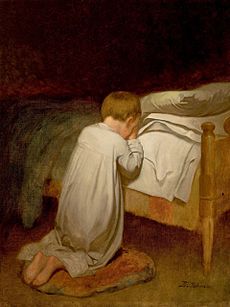Matthew, Mark, Luke and John facts for kids
Quick facts for kids "Matthew, Mark, Luke and John" |
|
|---|---|
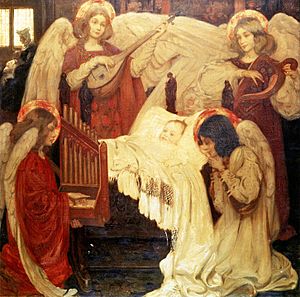
"Four corners to my bed" by Isobel Lilian Gloag (1868–1917)
|
|
| Nursery rhyme | |
| Written | Unknown |
| Published | 1656 |
"Matthew, Mark, Luke and John" is a famous English nursery rhyme and bedtime prayer for children. It is also known as the "Black Paternoster". This rhyme has a special number in the Roud Folk Song Index, which is 1704.
The prayer might have very old roots, possibly from ancient Babylonia. A Christian version was used in Germany during the late Middle Ages. The first known English version appeared around the mid-1500s. English writers at the time sometimes called it a "popish" or magical charm. It is connected to other old prayers, like the "Green" and "White Paternoster," which were used in England during the Middle Ages. This rhyme has inspired many famous writers, like Henry Wadsworth Longfellow, and musicians, such as Gustav Holst. People have also created different versions and funny parodies of it.
Contents
Lyrics of the Rhyme
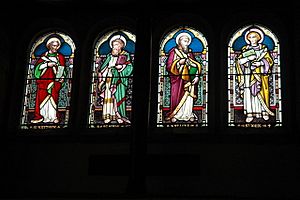
The most common version of "Matthew, Mark, Luke and John" that people know today is:
Matthew, Mark, Luke and John,
Bless the bed that I lie on.
Four corners to my bed,
Four angels round my head;
One to watch and one to pray
And two to bear my soul away.
The Roud Folk Song Index is like a big catalog for folk songs and their different versions. It lists this song as number 1704.
Where the Rhyme Began
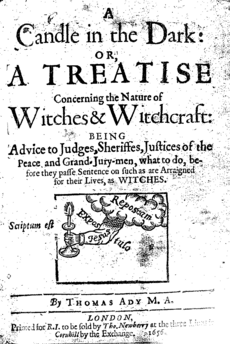
This rhyme might be one of the few English nursery rhymes with very old beginnings. For example, an ancient Babylonian prayer said, "Shamash before me, behind me Sin, Nergal at my right, Ninib at my left." This sounds a bit like a medieval Jewish prayer used before sleep: "In the name of the Lord, the God of Israel, may Michael be at my right hand; Gabriel at my left; Uriel before me; Raphael behind me and the Shekhinah of God be above my head."
A Christian version of this prayer was found in Germany around the end of the Middle Ages. However, the first time these lyrics were written down in English was in 1656. This was in a book about witchcraft by Thomas Ady called A Candle in the Dark. The book tells a story about a woman in Essex, England. She lived during the time of Queen Mary I (1553-1558) and was still alive when Ady wrote his book. She would bless herself every night with what he called a "popish charm":
Matthew, Mark, Luke and John,
The Bed be blest that I lye on.
In 1685, George Sinclair wrote about Scotland in his book Satan's Invisible World Discovered. He repeated Ady's story. Sinclair also mentioned a witch who used a "Black Paternoster" at night. This prayer was very similar to Ady's rhyme:
Four newks in this house, for haly Angels,
A post in the midst, that's Christ Jesus,
Lucas, Marcus, Matthew, Joannes,
God be into this house, and all that belangs us.
A year later, in 1686, John Aubrey quoted the rhyme again. His version was slightly different:
Matthew, Mark, Luke, and John,
Bless the bed that I lye on.
And blessed Guardian-Angel keep
Me safe from danger whilst I sleep.
The version of the rhyme that is most common today was first written down by Sabine Baring-Gould in 1891. It remained a popular children's prayer in England throughout the 1900s.
The "White Paternoster"
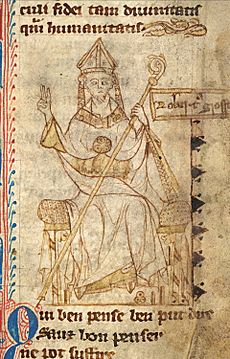
Robert Grosseteste (around 1175–1253) was a Bishop of Lincoln. He criticized old women for using a "Green Paternoster." This was a prayer that mentioned "Green Pater Noster, Peter's dear sister."
In Chaucer's famous story, "Miller's Tale" (written around 1387), he talks about a prayer called the "White Paternoster." Parts of this prayer, especially blessing the four parts of a house, are similar to the later "Black Paternoster":
Therwith the nyght-spel seyde he anon-rightes
On four halves of the hous aboute
And on the thresshfold of the dore withoute:
Jesus Crist and Seint Benedight,
Bless this hous from every wickked wight,
For the nyghts nerye the white pater-noster!
Where wentestow, Seinte Petres suster?'
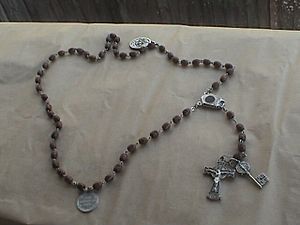
The mention of "St. Peter's sister" might actually mean St. Peter's daughter, St. Petronilla, who was known in England as St. Parnell. Some people think that the different colors (like "Black," "Green," and "White") linked to these prayers might have come from the colors of prayer beads. Different colored beads were used to help people remember to say different prayers, like aves and paternosters.
After the Reformation, the "White Paternoster" and other prayers were sometimes changed into magical rhymes. They became well-known charms. In 1608, a minister from Lancashire named John White wrote a book called The Way to the True Church. In it, he listed many "superstitions" of the people in Lancashire, including a "White Paternoster":
White Pater-noster, St Peter’s brother,
What hast i’ th' t’one hand? White booke leaves.
What hast i’ th' t’other hand? heaven yate keys.
Open heaven Yates, and steike shut hells Yates:
And let every chrisome child creep to its own mother.
White Pater-noster, Amen.
In 1685, George Sinclair compared the "Black Paternoster," which was used at night, with a "White Paternoster," which was used during the day.
White paternoster,
God was my Foster.
He fostered me Under the Book of Palm-Tree,
St Michael was my Dame,
He was born at Bethelem.
He was made of flesh and blood.
God send me my right food;
My right food, and dyne two,
That I may to yon Kirk go
To read upon yon sweet Book,
Which the mighty God of heaven shoop.
Open, open Heaven's Yaits,
Steik, Steik, Hell's Yaits.
All the saints be better,
That hear the white prayer Pater Noster.
Funny Versions and Satires
This rhyme has often been used to create funny versions or satires. One common funny version was recorded in Scotland in the 1840s. Boys would use it in a game with a hobby horse. The lyrics were:
Matthew, Mark, Luke and John,
Hold the horse till I get on;
When I got on I could not ride,
I fell off and broke my side.
Another version from the United States, recorded in 1900, started like this:
Matthew, Mark, Luke and John,
Saddle the horse till I get on...


